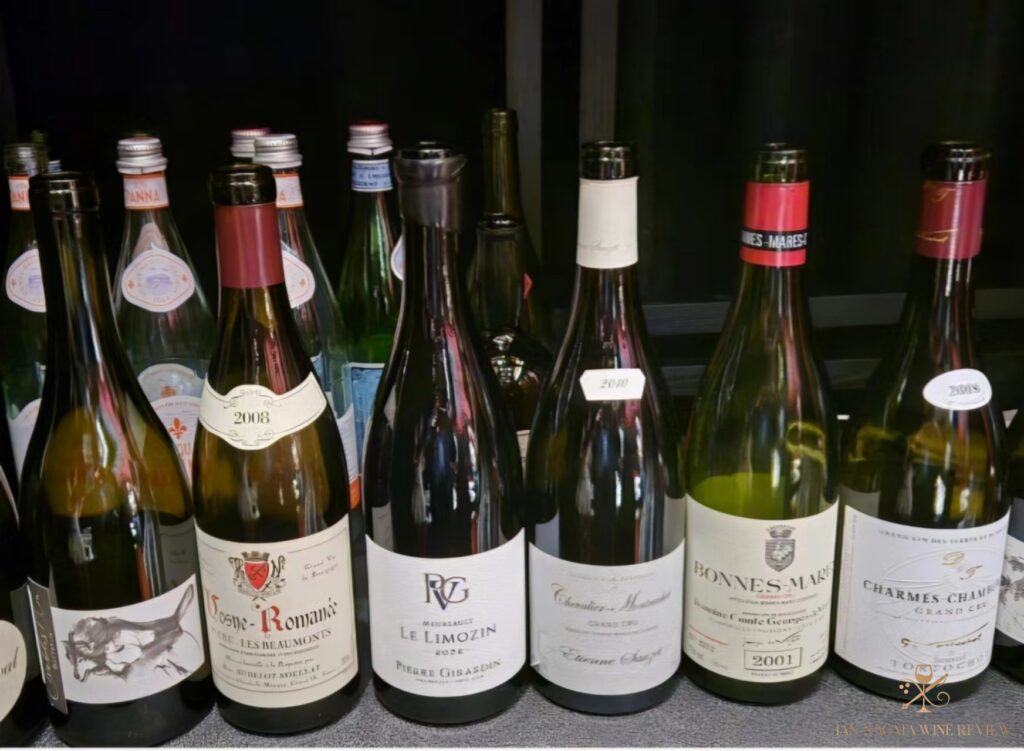Burgundy is famous for how much it can express with (mostly) just two grape varieties (let’s not forget about lovely Aligoté). Through Chardonnay and Pinot Noir, the region reveals an incredible range shaped by soil, climate, and the people behind the wines. Each bottle carries its own character—a reflection of place, vintage, and the choices made in the cellar.
Chardonnay, in particular, shows remarkable adaptability. In Chablis, it comes across as sharp and mineral, thanks to its marine limestone soils. In Meursault, it becomes broader and creamier, rich in texture. And in the heights of Montrachet and affiliate terroirs, it shows a graceful lightness and refined elegance combined with power and complexity. It’s not a grape that insists on a fixed identity—it’s one of exceptional malleability, able to take on entirely different forms depending on where and how it’s grown and made.
Of course, place is only part of the story. The winemaker’s hand plays an equally important role. Decisions around oak, lees contact, malolactic fermentation, harvest timing, and aging all leave their mark on the wine. In Burgundy, the final result is never just a product of the vineyard—it’s a dialogue between nature, time, and the person guiding the process. The first three wines in this tasting are all made from Chardonnay, yet each one represents a distinctly different subregion of Burgundy. They illustrate not just the grape’s adaptability, but also the influence of soil, climate, and local winemaking tradition—revealing how Chardonnay shifts its voice across environments.
Chablis sits at the northernmost edge of Burgundy. It’s one of the region’s coolest zones, with long ripening seasons and low sunlight intensity. The soils are dominated by Kimmeridgian limestone (though Portlandian soils also have a role to play, albeit a different one), rich in fossilized marine matter. Butteaux, a sub-area within the Montmains Premier Cru, features clay and marl soils with a high concentration of shell fragments and sea fossils. This combination lends the wines a mineral core wrapped in subtle texture. Here, Chardonnay speaks in its most “original” dialect—bright, linear, and unadorned. The wines carry notes of citrus, crushed seashells, and saline minerality, often without the use of oak. What emerges is a wine built on purity and precision, shaped directly by the soil beneath it.
In the central stretch of the Côte de Beaune, Meursault marks a stylistic shift for Chardonnay—toward roundness, richness, and layered expression. Though the village has no Grand Crus, it is home to several highly respected Premier Crus and outstanding lieux-dits. Le Limozin, while not a Premier Cru, is a named vineyard plot that borders top sites like Charmes and Genevrières, and is often considered among the best of Meursault’s village-level parcels. The soils here are composed primarily of marl and limestone, with a higher clay content than in the north. The site offers moderate slopes, favorable exposure, and a warmer climate than Chablis, allowing for more complete ripening and a fuller flavor profile. Compared to the linear coolness of Chablis, Meursault offers a softer, rounder, and more enveloping expression of Chardonnay. In this context, the grape takes on more volume and structure—becoming a generous interpretation shaped by warmer, richer conditions.
Chevalier-Montrachet is located on the Puligny side of the Montrachet hill (and its wines show that), reaching elevations up to 350 meters. It is the highest and one of the most revered of the Montrachet-named Grand Crus (others are Bâtard-Montrachet and Criots-Bâtard-Montrachet, for example). The soils are shallow and stony, with a top layer composed of brown clay and small limestone stones, offering excellent drainage. The vineyard faces southeast, and its high-altitude, cool-exposure slope helps to prolong ripening and preserve acidity. The presence of brown clay here is especially significant. Rich in minerals and organic matter, it helps retain moisture and regulate vine vigour, contributing to depth and concentration in the wine. Beneath it, the abundance of broken limestone ensures precision, freshness, and a strong sense of minerality. Together, these elements give the Chardonnay from Chevalier-Montrachet both structure and acidity, along with remarkable tension and clarity. It’s worth noting that brown clay is not unique to Chevalier. Similar clay-limestone structures can be found in other Côte de Beaune Grand Crus, such as Corton-Charlemagne, where the style tends to lean toward power and richness. But in Chevalier, its high-altitude setting and exceptional drainage create a rare equilibrium—one that balances strength with elegance, and delivers a style defined by precision and finesse. If Meursault speaks of volume and sculpted form, then Chevalier conveys clarity and verticality—a Chardonnay rendered in high resolution.
Following the exploration of three distinctive expressions of Chardonnay, we now turn to Burgundy’s great red grape and a truly unique interpreter of terroir: Pinot Noir. The second half of the tasting featured three red wines from emblematic villages of the Côte de Nuits: Vosne-Romanée, Gevrey-Chambertin, and Chambolle-Musigny, represented respectively by Vosne-Romanée Premier Cru Les Beaumonts, Charmes-Chambertin Grand Cru, and Bonnes Mares Grand Cru.
Though all three wines are made from the same grape (more or less: biotypes play a huge if still relatively little-known role, but that’s a discussion for another time), their stylistic personalities are remarkably distinct—together forming a clear stylistic arc: from perfume and finesse, through richness and breadth, to structure, minerality, and vertical depth.
Vosne-Romanée, located between Nuits-Saint-Georges and Vougeot, is one of Burgundy’s most prestigious villages. With moderate slopes facing southeast and well-drained, fine limestone soils, it provides stable ripening and exceptional aromatic precision. Wines from Vosne-Romanée are known for their elegance, balance, and layered complexity. Aromas often include clove, rose petal, black cherry, and exotic spice, supported by silky tannins and fine acidity. It is a benchmark of Pinot Noir’s graceful side. (For more information on the wines of this commune, please also see: Ian D’Agata Wine Review, March 7, 2025: The Wines of Vosne-Romanée Premier Crus.)
Charmes-Chambertin, one of the nine Grand Crus of Gevrey-Chambertin, sits on the village’s southern flank, mostly at the foot of the slope. The soils are deeper and richer in clay and iron, and the site enjoys generous sunlight. These conditions produce wines with a fuller body, expressive fruit, and rounded structure, perhaps contributing to the choice of the name “Charmes” that was attached to that of Chambertin. Among Gevrey’s crus, Charmes is often considered the most approachable and outwardly charming—delivering breadth and generosity over austerity. Typical notes found in these wines include blackberry, licorice, forest floor, and spice.
Bonnes-Mares, a rare Grand Cru that straddles two villages—Chambolle-Musigny and Morey-Saint-Denis—offers a completely different register. The wine tasted here comes from the Chambolle side, known for its higher elevation, steeper slopes, and soils composed of limestone scree and reddish-brown clay. These factors combine to produce wines that emphasize structure, minerality, and vertical tension. Aromatics often include wild rose, moss, dried herbs, and crushed stone. Tannins are firm and linear, the mouthfeel more architectural than seductive. Compared to Musigny’s grace, the other grand cru of the commune of Chambolle-Musigny, Bonnes-Mares often feels colder, deeper, and more sculpted in form. (For more information on the wines of this commune, please also see our previously published feature: Ian D’Agata Wine Review, April 25, 2025: Chambolle-Musigny Premier Cru Dinner: An Elegant Exploration of the Subtle Terroir.)

The wines in this tasting report
All the wines in this report were tasted in Shanghai in June 2025.



